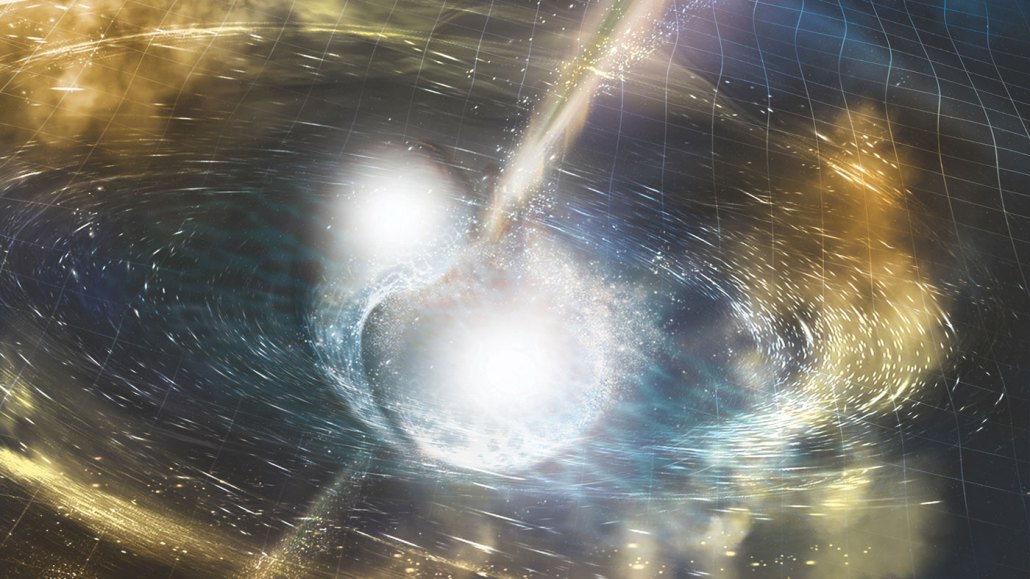Let’s learn about gravitational waves
These ripples in spacetime offer clues about extreme objects and phenomena, such as black-hole smashups

Wiggles in spacetime known as gravitational waves provided the first evidence of a collision between two distant neutron stars (illustrated here).
NSF/LIGO/Sonoma State University/A. Simonnet
Share this:
- Share via email (Opens in new window) Email
- Click to share on Facebook (Opens in new window) Facebook
- Click to share on X (Opens in new window) X
- Click to share on Pinterest (Opens in new window) Pinterest
- Click to share on Reddit (Opens in new window) Reddit
- Share to Google Classroom (Opens in new window) Google Classroom
- Click to print (Opens in new window) Print
As stable as it may seem, space is actually quite stretchy. All objects in the universe bend the fabric of space and time, or spacetime. More massive objects warp it more severely. Such distortions are felt as gravity. Objects can also churn up ripples in spacetime as they move through it, with heftier objects making bigger ripples. Such undulations are known as gravitational waves.
Albert Einstein predicted the existence of these waves about a century ago. But gravity waves were spotted for the first time only a few years ago. Why? Because gravity waves fade as they spread out, like ripples in a pond. So, by the time waves from distant celestial objects wash over Earth, they’re tiny. Like only a thousandth the width of a proton! Only the most extreme objects in the cosmos make big enough waves for instruments on Earth to pick up.
Physicists detected the first gravitational waves in 2015. The Advanced Laser Interferometer Gravitational-Wave Observatory, or LIGO, made the find. These waves had come from two distant black holes slamming into each other. This discovery won three scientists the Nobel Prize in physics in 2017.
Since then, dozens of gravity-wave events have been detected. LIGO has spotted them, along with the Advanced Virgo observatory in Italy. These events include the first known smashup of two neutron stars.
In the future, scientists hope to find gravity waves triggered by other powerful objects and events. Stellar explosions, for example. Or spinning neutron stars. Or hypothetical tunnels in spacetime called wormholes. Radiation from the birth of the universe may even bear the marks of gravity waves caused by the Big Bang.
Want to know more? We’ve got some stories to get you started:
Gravitational waves ‘kicked’ a newborn black hole across space When two black holes smashed into each other, the gravitational waves they kicked up flung the newborn black hole across space. (3/25/2022) Readability: 6.5
Could ripples in spacetime point to wormholes? Such tunnels in the fabric of spacetime may be visible through unusual gravitational waves. (8/24/2020) Readability: 7.3
Gravity waves detected at last! In February 2016, physicists announced that they had finally detected gravitational waves — which were predicted a century before. (2/11/2016) Readability: 6.9
Explore more
Explainer: What are gravitational waves?
Astronomers finally find the cosmic source of gold and silver
Trio wins physics Nobel for detecting gravity waves
Gravitational waves detected yet again
Spinning black holes may ‘sing’ during a collision
Black hole smashup sent out ‘yottawatts’ of power
Zombie stars: A source of gravitational waves?
Explore every gravitational wave event spotted so far (Science News)
Activities
How exactly do gravitational-wave detectors pick up ripples in the fabric of spacetime? NASA has a fun activity to visualize how this works. Prep a pan of gelatin and grab a laser pointer to create your own mini model of gravitational-wave detection.







